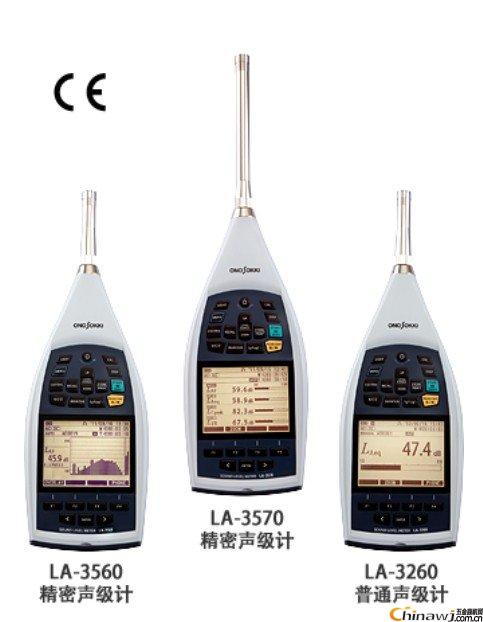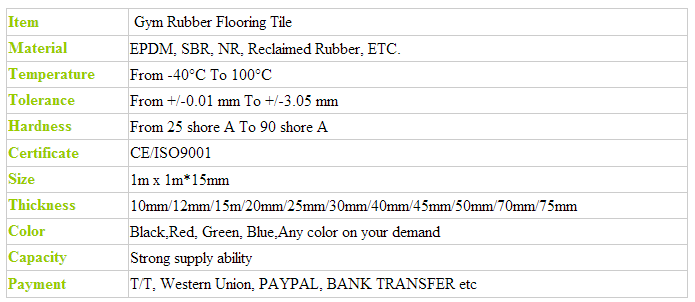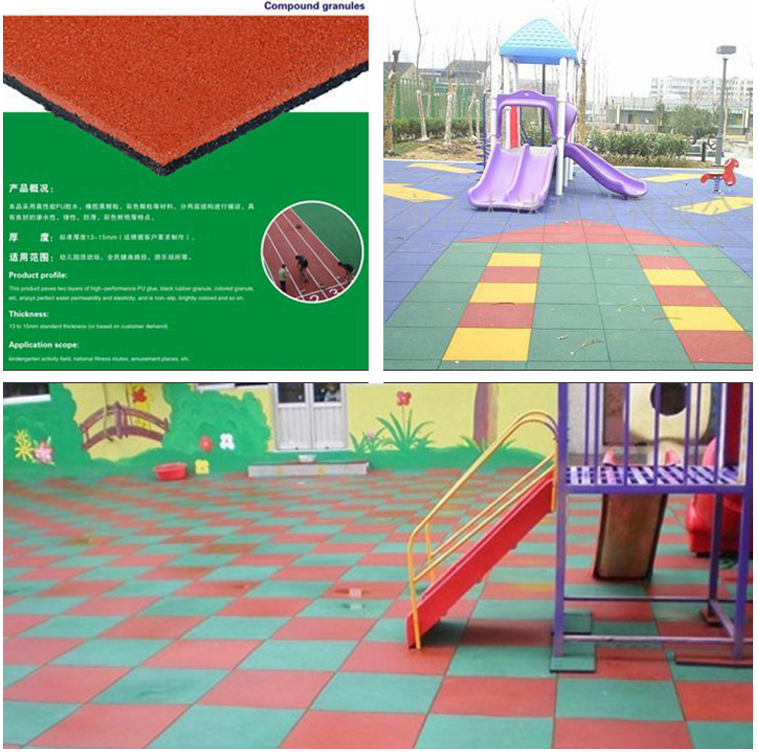The working principle and application of noise meter / sound level meter
This Rubber Gym Flooring has the advantages on the followings:
1. Quality warranty: our rubber gym flooring produced strictly by the international standards, from the external looking to the quality control.
2. Characteristic for sports: Non-toxic, wear-resistance, anti-slip, shockabsorption and cushion, flexible and temperature resistant.
3. Service: rich OEM service and after-sale service.
Feature:
1.Wear resistant
Scope of usage:
Sports areas: sports center,wushu school.shooting gallery, gymnastics.
Our Advantage
1. Our factory: specializing in Rubber Sheet &rubber bumper block& rubber stair steps for 10 years, we can give you the best price and professional service.
2. Quality control: We have excellent management team in order to make the best quality products for its customers.
3. Fast delivery: We have more than 200 workers, high production capacity.
4. Our services: We can according to your request then specially designed making products for you
LA-3260, LA-3560, LA-3570, LA-1410, LA-1440, LA-4440 Japan Ono noise meter / sound level meter!
Guangzhou Chengmin Electronic Technology Co., Ltd. professional advantage to supply imported, domestic brand industrial noise meter / sound level meter! A large number of spot advantages supply! Welcome to inquire and purchase:
Liu Gong 15915719483
phone
fax
QQ
How the noise meter / sound level meter works:
The sound is converted into an electrical signal by the microphone, and the impedance is converted by the preamplifier to match the microphone to the attenuator. The amplifier adds the output signal to the weighting network, performs frequency weighting (or external filter) on the signal, and then amplifies the signal to a certain amplitude through the attenuator and the amplifier, and sends it to the RMS detector (or externally pressed) Flat recorder), the value of the noise level is given on the indicator head.
1) A microphone is a device that converts a sound pressure signal into a voltage signal, also called a microphone, which is a sensor of a sound level meter. Common microphones are available in crystal, electret, moving coil and capacitive.
1.1 The moving coil microphone consists of a vibrating diaphragm, a movable coil, a permanent magnet and a transformer. The vibrating diaphragm starts to vibrate after being subjected to the sound wave pressure, and drives the movable coil mounted with it to vibrate in the magnetic field to generate an induced current. This current varies depending on the magnitude of the sound wave pressure of the diaphragm. The larger the sound pressure, the larger the current generated, and the smaller the sound pressure, the smaller the current generated.
1.2 Capacitive microphone is mainly composed of a metal diaphragm and a metal electrode that is close to each other, and is essentially a plate capacitor. The metal diaphragm and the metal electrode constitute two plates of the plate capacitor. When the diaphragm is subjected to the sound pressure, the diaphragm is deformed, and the distance between the two plates is changed, thus changing the capacitance. The voltage in the bit measurement circuit also changes, realizing the effect of converting the sound pressure signal into a voltage signal. Capacitive microphones are ideal microphones for acoustic measurement. They have wide dynamic range, flat frequency response, high sensitivity and good stability in general measurement environments. Since the output impedance of the condenser microphone is very high, the impedance conversion by the preamplifier is required, and the preamplifier is installed inside the sound level meter near the portion where the condenser microphone is mounted.
2) Amplifiers typically use two-stage amplifiers, the input amplifier and the output amplifier, which act to amplify the weak electrical signal. The input attenuator and output attenuator are used to vary the amount of attenuation of the input signal and the amount of attenuation of the output signal in order to position the pointer to the appropriate position. The output of the attenuator used by the input amplifier is adjusted to the low end, and the attenuator used by the output amplifier is adjusted to the high end of the measurement. The high and low ends of many sound level meters are bounded by 70dB.
3) The weighting network has different sensitivity in simulating human hearing at different frequencies. In the sound level meter, there is a network capable of simulating the auditory characteristics of the human ear and correcting the electrical signal to an approximation of the sense of hearing. Called the weighting network. The sound pressure level measured by the weighted network is no longer the sound pressure level of the objective physical quantity (called the linear sound pressure level), but the sound pressure level corrected by the hearing sense, which is called the weighted sound level or the noise level.
The weighting (also called weighting) parameter is a parameter measured after some weighting processing on the frequency response curve to distinguish it from the unweighted parameter in the flat frequency response state. For example, the signal-to-noise ratio, by definition, we measure the noise level (which can be power, or voltage, current) at the rated signal level. The ratio of the rated level to the noise level is the signal-to-noise ratio. The decibel value is used to calculate the difference between the two. This is a non-weighted signal to noise ratio. However, since the human ear's perception of noise in each frequency band is different, it is the most sensitive to the intermediate frequency of about 3 kHz, and the difference between the low frequency and the high frequency. Therefore, the unweighted signal-to-noise ratio does not necessarily have the subjective feeling of noise to the human ear. Can kiss very well.
How to unify the measured value with the subjective sense of hearing? Then there is a balanced network, or a weighted network, which moderately attenuates both low and high frequencies, so that the intermediate frequency is more prominent. The weighted network is connected between the device under test and the measuring instrument, so that the influence of the intermediate frequency noise of the device is "amplified" by the network. In other words, the intermediate frequency noise that has the greatest impact on the sense of hearing is given a higher weight. The measured signal-to-noise ratio is called the weighted signal-to-noise ratio, which can more realistically reflect the subjective sense of hearing.
Depending on the weighting network used, they are called A sound level, B sound level and C sound level, and the units are recorded as dB(A), dB(B) and dB(C). The A-weighted sound level is the frequency characteristic of the low-intensity noise of the simulated human ear to 55dB or less, the B-weighted sound level is the frequency characteristic of the medium-intensity noise simulating 55dB to 85dB, and the C-weighted sound level is the frequency characteristic of simulating the high-intensity noise. . The main difference between the three is the degree of attenuation of the low-frequency components of the noise, A is the most attenuated, B is the second, and C is the least. A weighted sound level is the most widely used noise measurement in the world because its characteristic curve is close to the human ear's auditory characteristics. Many noise-related national specifications are based on the A sound level. However, due to the large change in the lamp response curve based on A-weighting, the status of A-weighting is gradually declining. The current popular weighting standards include NR and NC lamp standards.
4) Detector and Indicator The detector function is to convert a rapidly changing voltage signal into a slower changing DC voltage signal. This DC voltage is proportional to the size of the input signal. Depending on the needs of the measurement, the detector has a peak detector, an average detector and a rms detector. The peak detector can give the maximum value over a certain time interval, and the average detector can measure its absolute average value over a certain time interval. The pulse sound needs to measure its peak value, and the rms detector is used in most noise measurements.
The rms detector can square, average, and square the AC signal to obtain the rms value of the voltage, and finally deliver the rms voltage signal to the indicator head. At present, the sound level meter for measuring noise can be divided into four types according to the sensitivity:
(1) "Slow". The head time constant is 1000 ms, which is generally used to measure steady-state noise, and the measured value is an effective value.
(2) "Fast". The time constant of the meter is 125ms, which is generally used to measure unsteady noise and traffic noise with large fluctuations. The fast gear is close to the human ear's reaction to the sound.
(3) "Pulse or pulse hold". The needle rise time is 35ms, which is used to measure impulse noise with a long duration, such as punching, pressing hammer, etc., and the measured value is the maximum effective value.
(4) "Peak hold". The needle rise time is less than 20ms. Used to measure pulse sounds with very short durations, such as guns, guns, and explosions. The measured value is the peak value. That is the maximum.
Http://news.chinawj.com.cn  Editor: (Hardware Business Network Information Center) http://news.chinawj.com.cn
Editor: (Hardware Business Network Information Center) http://news.chinawj.com.cn 
2.Weather proof
3.Slip resistant
4.shock absorbent
5.Environmental safety
6.Sound-absorbing, sound insulation

Public places: school sports instruments room,kindergarten,nursery,fitness room,path,pedestrian bridges,parks,stations,shopping malls etc.
Leisure and entertainment place:Children`s playground,elderly centers,training room,dancing room,bath center,swimming pool and other shore
Building construction: Office buildings,hotels,restaurants corridors,residential areas,outdoor plaza,KTV,office
Home use:Bathroom,bedroom,balcony,living room

Playground Rubber Tile
Playground Rubber Tile,Rubber Tiles,Playground Tiles,Playground Rubber Fooring Tiles
Renqiu Xingcheng Rubber Products Co., Ltd. , https://www.rubbermats.nl